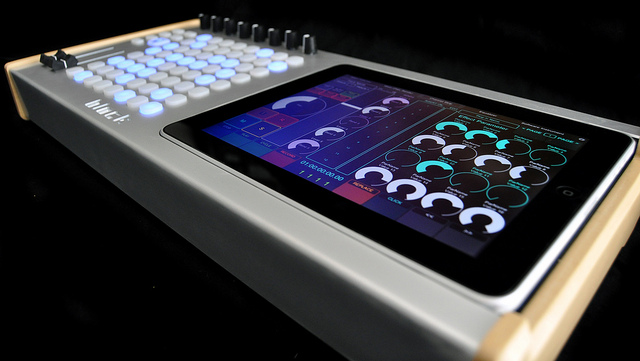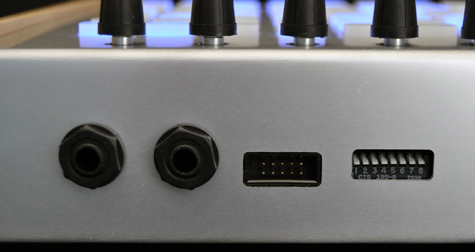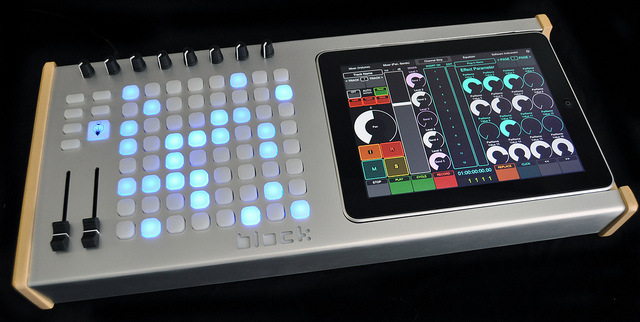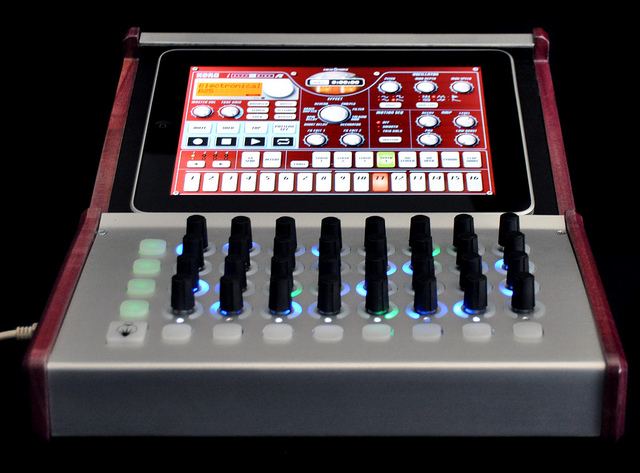
In the never-ending quest to find just the right combination of faders and knobs for piloting your music, here’s a thought: add expansion capabilities. An upgrade to the Block, a grid grid and knob control surface by boutique Texan maker Livid, does just that. And for good measure, they’ve got a short-run iPad dock alternate, too, for those of you who want touch control and apps but want hardware control, too. That raises another set of ideas gaining traction this week: why not add tangible controls to these multi-touch tablets and such?

Room to Grow
At the heart of Livid’s controllers is something they call the Brain – the basis of a modular control surface. DIYers can build controllers from the ground up as part of their Builder system, or you can buy a controller like the Block that works out of the box. What Livid has done on the Block is effectively to give you both. You can use the controller out of the box, but you can use the 1/4″ jacks to connect sensors or foot pedals, and a pin header connection that adds eight more sensors. It means you can do a smaller DIY project for just the stuff you need, but without having to do all the hard stuff necessary to get the knobs and light-up pads the Block already has. More details in the Livid blog post, or see the demo video below.
So that’s taking a tangible controller and adding to it. But what about the tablet and multi-touch control surface craze? Musicians are subverting the very feature of these tablet computers that supposedly makes them popular. DIYers are liberating control from those shiny, black, hermetically-sealed consumer goods, a bit like cracking into some alien artefact. We’ve already seen hardware from one commercial maker – Akai – that sits an iOS device in a keyboard dock (the SynthStation line). New options go still further:

Beyond the Tablet
Livid is doing a very limited run of the Block that includes a place to sit your iPad. (I’m actually a bit sorry that they make the space form-fitting, rather than have just an open shelf – in case you later swap tablets to something that’s a different size, for instance. But it’s a limited-run, and I guess if I want that, I’ll have to just commission Livid.)
As seen on Synthtopia, the design is now available. You get a class-compliant, driver-free controller that’s USB powered, features MIDI in and out jacks, 64 programmable, light-up pads, and the aforementioned expansion jacks. It’s a pretty full-featured product for US$460.
It’s just a prototype, and may never be available, but Livid also mocked up how their Code (a big array of knobs) would work with the iPad. I love the Moog-style angling of the shelf and the smaller footprint of this design. And it does appear that it’s a design that could accommodate different tablets, in case you have an iPad and an Android tablet. (Well, that’s true of a bunch of people who went to Google’s developer conference this week, if sadly I wasn’t one of them.)

From Touch to Tangible
Tablets, by merging display, computing, and touch control, make software easier to control. What they can’t do is provide the function tangible controls do. That is, they do what the mouse and display and keyboard do better in some instances, but they can’t replace knobs and faders.
A research project by Mike Kneupfel for New York University’s ITP digital media program investigates these issues.
Touchscreens like those found on smartphones and tablets have enabled a new generation of versatile user interfaces. My thesis project, Extending the Touchscreen, aims to further this versatility by using conductive materials to construct a series of physical, mechanical, and electrical devices that touch, interact and communicate directly through the touchscreen interface. My goal in constructing these external devices is to make touchscreen interactions more tactile, physical and potentially more expressive and fun.
As seen in the videos, he takes two approaches. One works directly with the sensing capabilities of the touchscreen itself, augmenting it with different hardware that would come in contact with the screen. The other makes use of the hardware connection.
For all the Apple fetishism, I think that Google may be able to pull away some folks tinkering with this with their new, far more open approach to hardware development. But what’s nice about Michael’s project here is that Google’s announcement this week that they were vastly expanding hardware I/O capabilities validates his research, and suggests lots more potential that can work even in a consumer, not just a tinkerer, context.
Lots of crazy stuff on his blog; see also the thesis page and coverage in Creative Applications.
Side note: it seems some of the add-on hardware you plop on a touchscreen doesn’t work all that well; see Victor Agreda, Jr.’s disappointed review of those stick-on joysticks. (CDM readers had tipped me off about those before.) But the other approaches here do show potential.
And whether a tangible controller or touchscreen tablet, having control that has room to grow has some serious appeal.